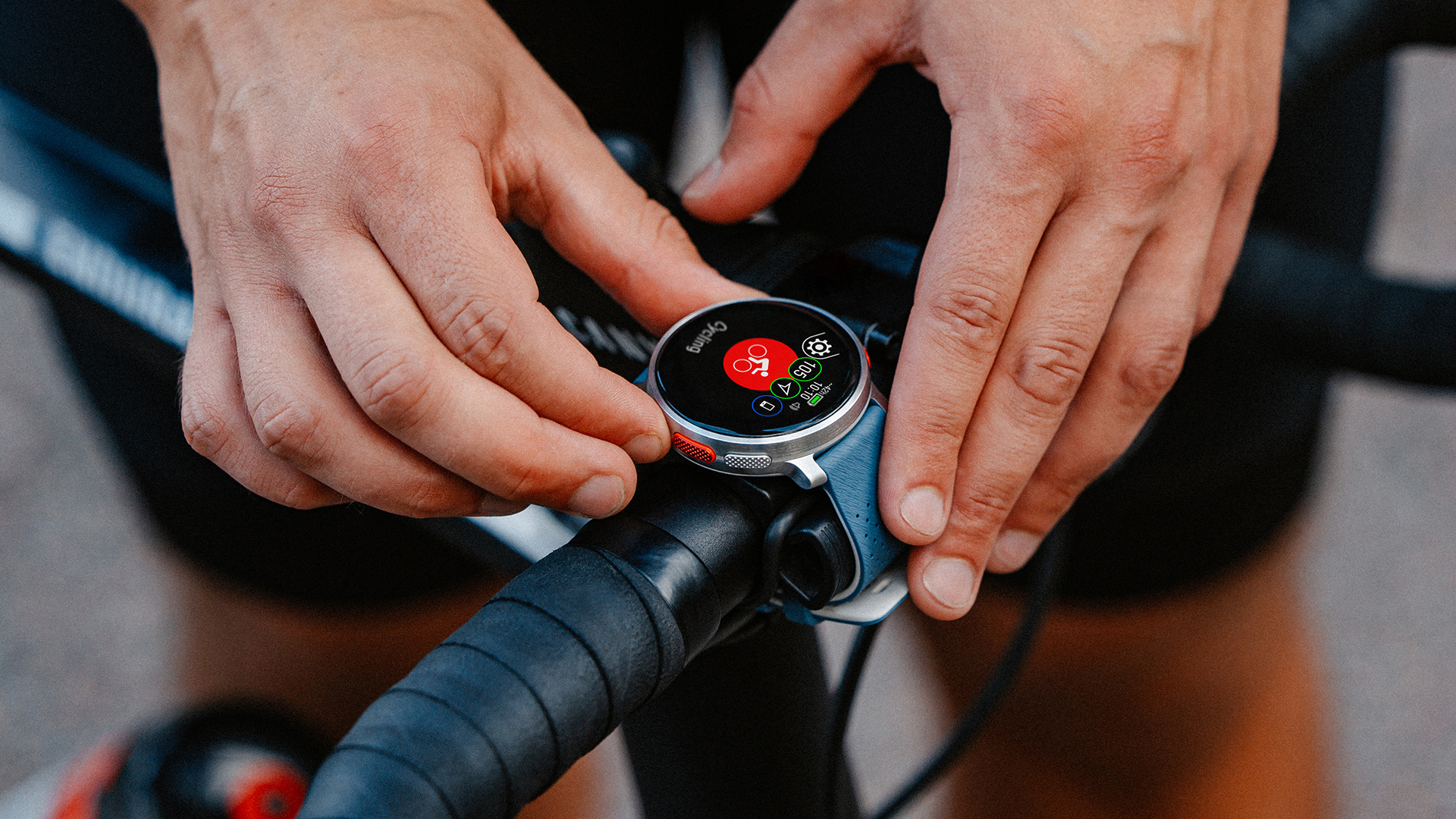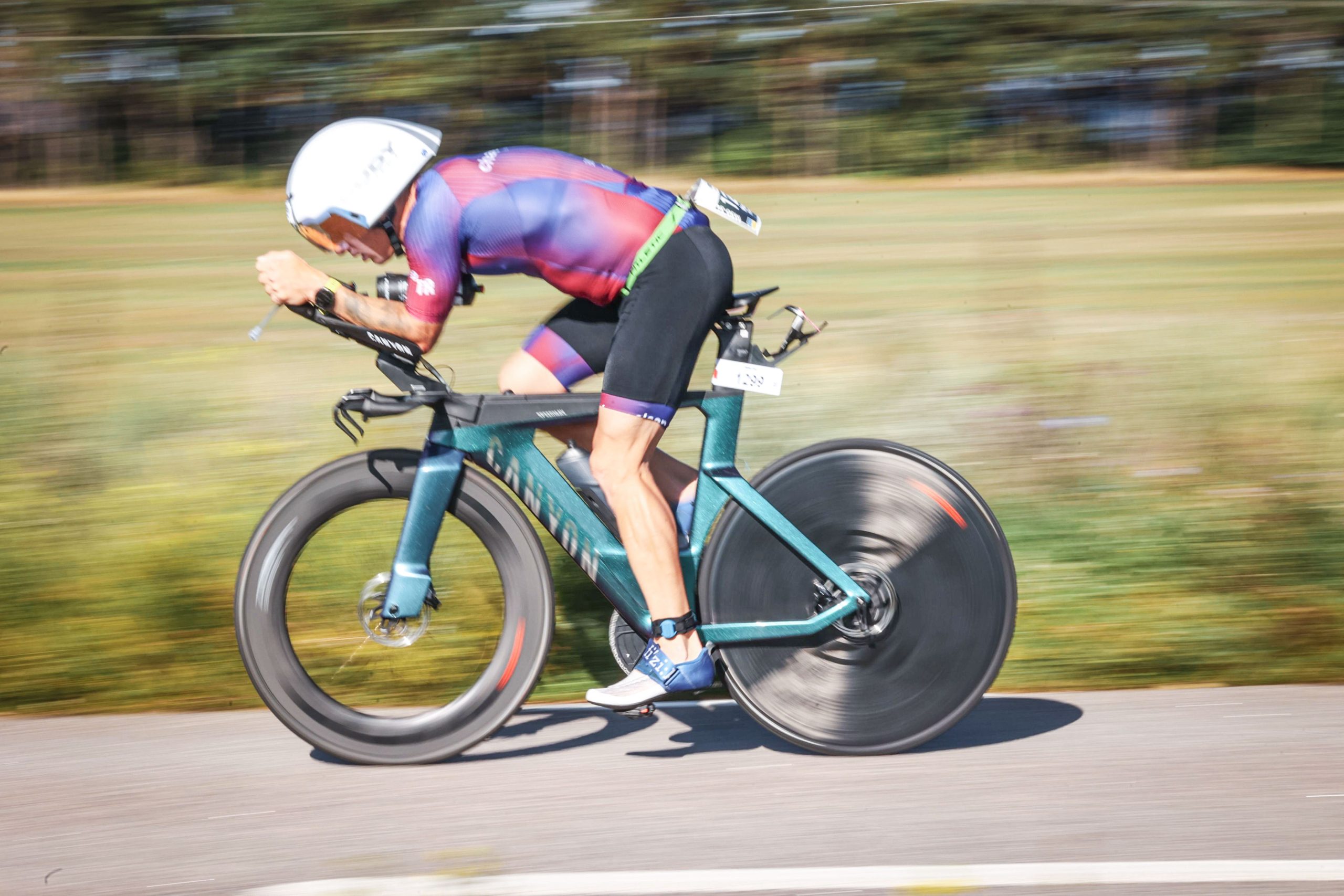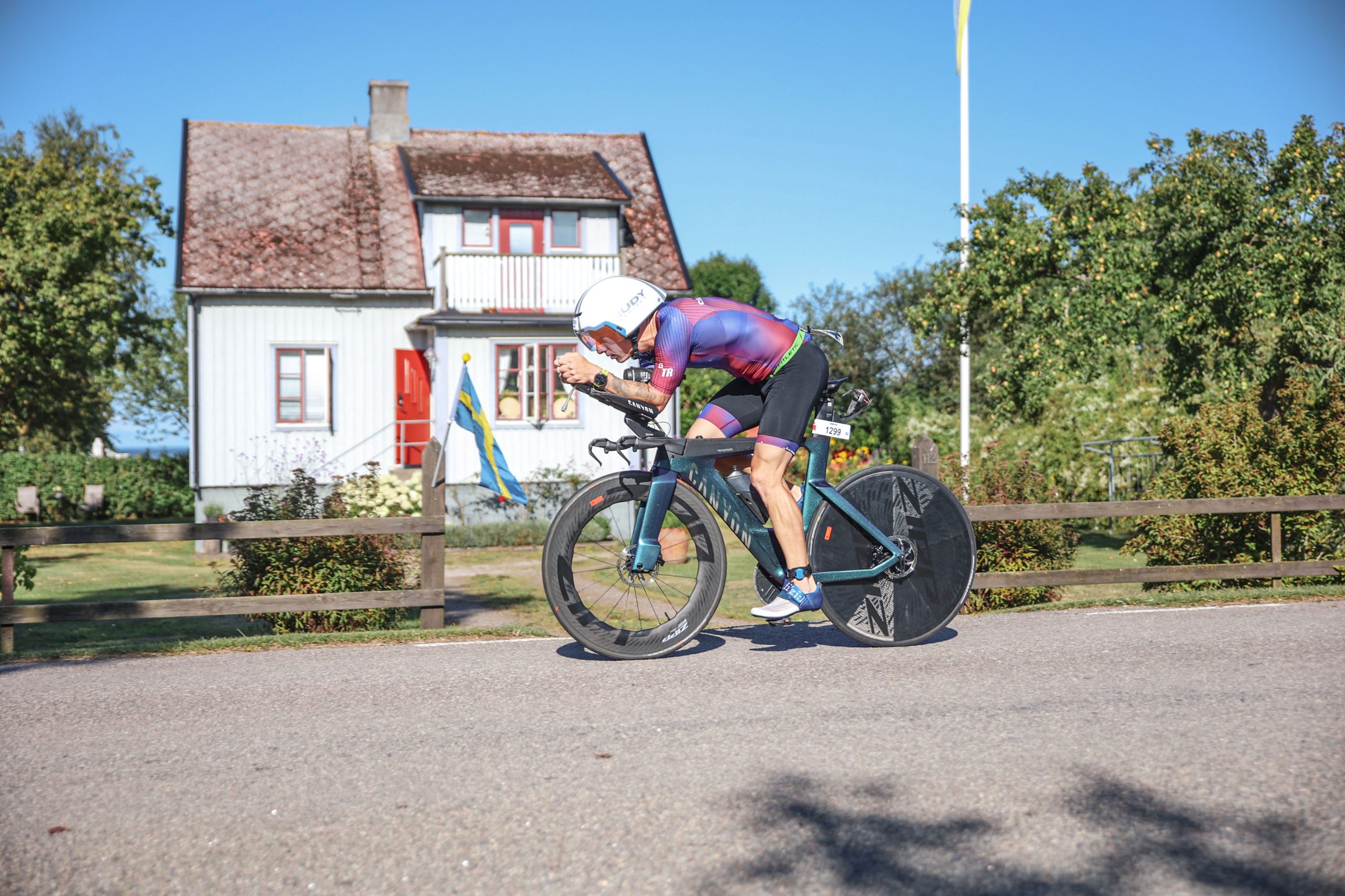Triathlon training pushes your body to the limit, and the right watch can make all the difference. Modern triathlon watches are endurance athletes’ best friends. They track heart rate, measure distance, record GPS routes, monitor recovery and sleep, and provide other advanced features.
With advanced training features and long-lasting batteries, they’re essential coaching tools on your wrist. But not all watches are created equal, so choosing one with reliable GPS tracking, accurate heart rate monitoring, and the right features is key to getting the most from every swim, bike, and run.
Here is more info about the best triathlon watches, how accurate they are, plus a checklist for choosing your next perfect triathlon watch.
The Validity of Smartwatch Data for Triathlon: A Study
Smartwatches have become a major fitness trend. They collect more health and movement data than ever. But their accuracy isn’t always reliable.
This study, called Validity of Current Smartwatches for Triathlon Training: How Accurate Are Heart Rate, Distance, and Swimming Readings?, for example, tested ten smartwatches for triathlon training.
They measured heart rates, running and cycling distances, swim stroke rates, and lap counts. Heart rate readings were compared to a chest strap during treadmill intervals with 30 participants. Running and cycling distances were tested on tracks, outdoor routes, and a 36.8 km bike course. Swimming tests included 200–400 m repeats in an Olympic-size pool.
Here is what they’ve got:
Heart rate data
This study tested 10 smartwatches for heart rate, distance, and stroke rate accuracy in running, cycling, and swimming.
Heart rate measurements were divided into average and maximum values. Average heart rates had errors of 3.1%–8.3%, while maximum heart rates were slightly more accurate at 3.1%–7.3%. High heart rates were generally underestimated, and low rates overestimated.
Accuracy also varied between runners. Some showed minimal deviations, while others had large errors up to 17% for average and 24.7% for maximum heart rates.
Wrist-based measurements were less accurate than chest straps. Differences may stem from individual runner movement that affects the optical sensors or timing offsets between watches and reference devices.
The study shows that both the smartwatch model and individual physiology influence heart rate accuracy.
Cycling data
For the 36.8 km road cycling course, all ten watches slightly underestimated the distance but performed better than running GNSS measurements.
Nine watches had MAPEs under 1%, with the POL watch the most accurate at just 0.03%. Seven significant deviations were observed, with large effect sizes, while three watches with fewer valid measurements (POL, FOS, FIT) showed no significant differences.
ANOVA confirmed that the watch model strongly influenced accuracy (η² = 0.775), and post-hoc analysis found 12 significant differences among the ten models.
Elevation measurements were notably inaccurate for AMA and HUA, likely due to altitude offsets and smoothed elevation data.
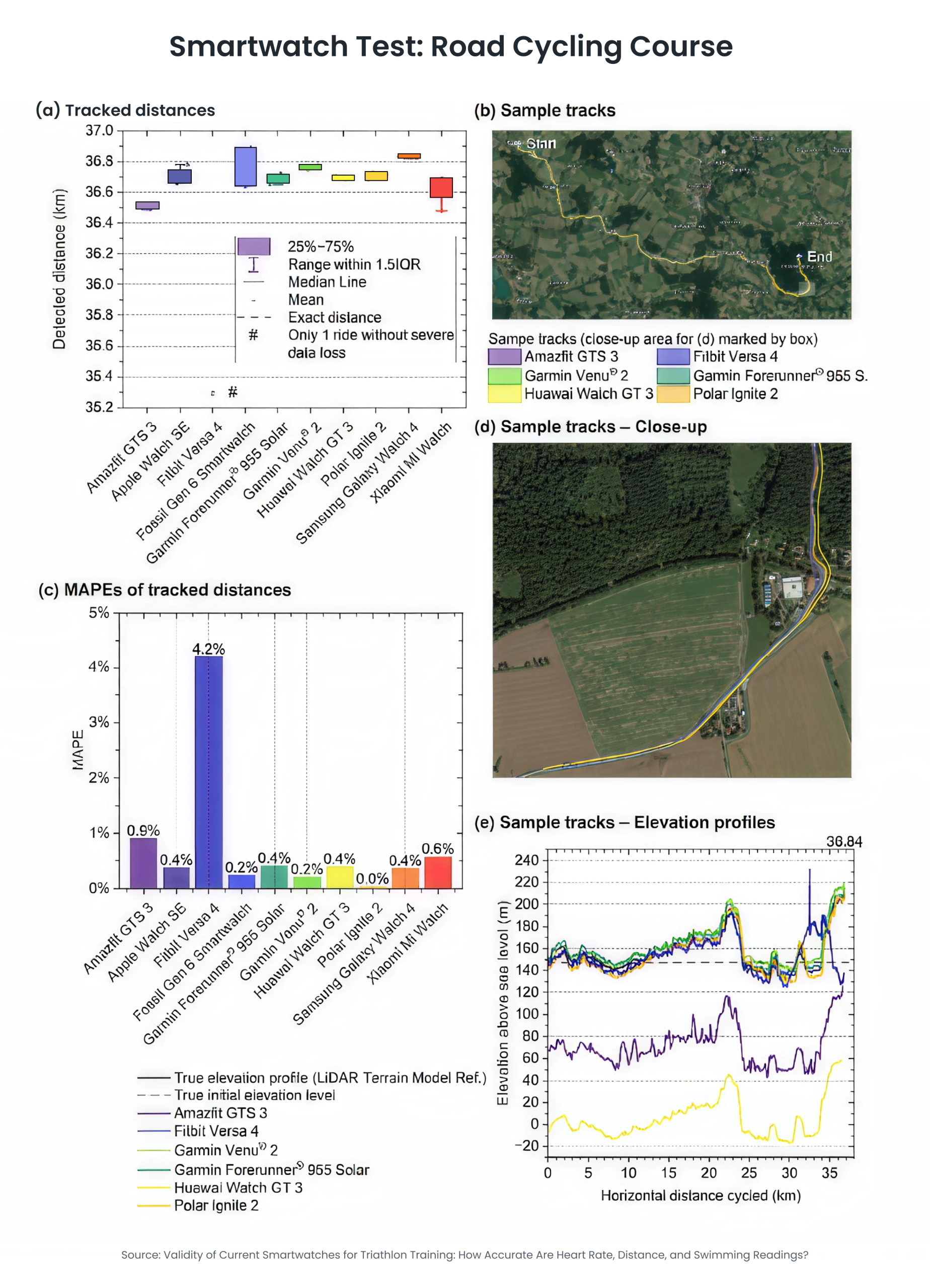
Running data
In the 4,000 m stadium track tests, seven of ten smartwatches measured distances within 2% of the true value. Average errors (MAPEs) ranged from 0.8% to 12.1%.
The FIT watch consistently underestimated distance, while FOS and XIA overestimated it, all showing large deviations. ANOVA confirmed that the smartwatch model strongly influenced accuracy (η² = 0.509).
Post-hoc tests found nine significant differences, mainly involving FIT compared to other models. Wrist placement had a minor effect: watches on the inner wrist averaged 3,946 m, and on the outer wrist 4,052 m—a 2.7% difference that was not statistically significant.
Overall, most watches gave reasonably accurate track measurements, but some models showed substantial errors. The findings highlight that both the watch model and individual device behavior can affect running distance accuracy.
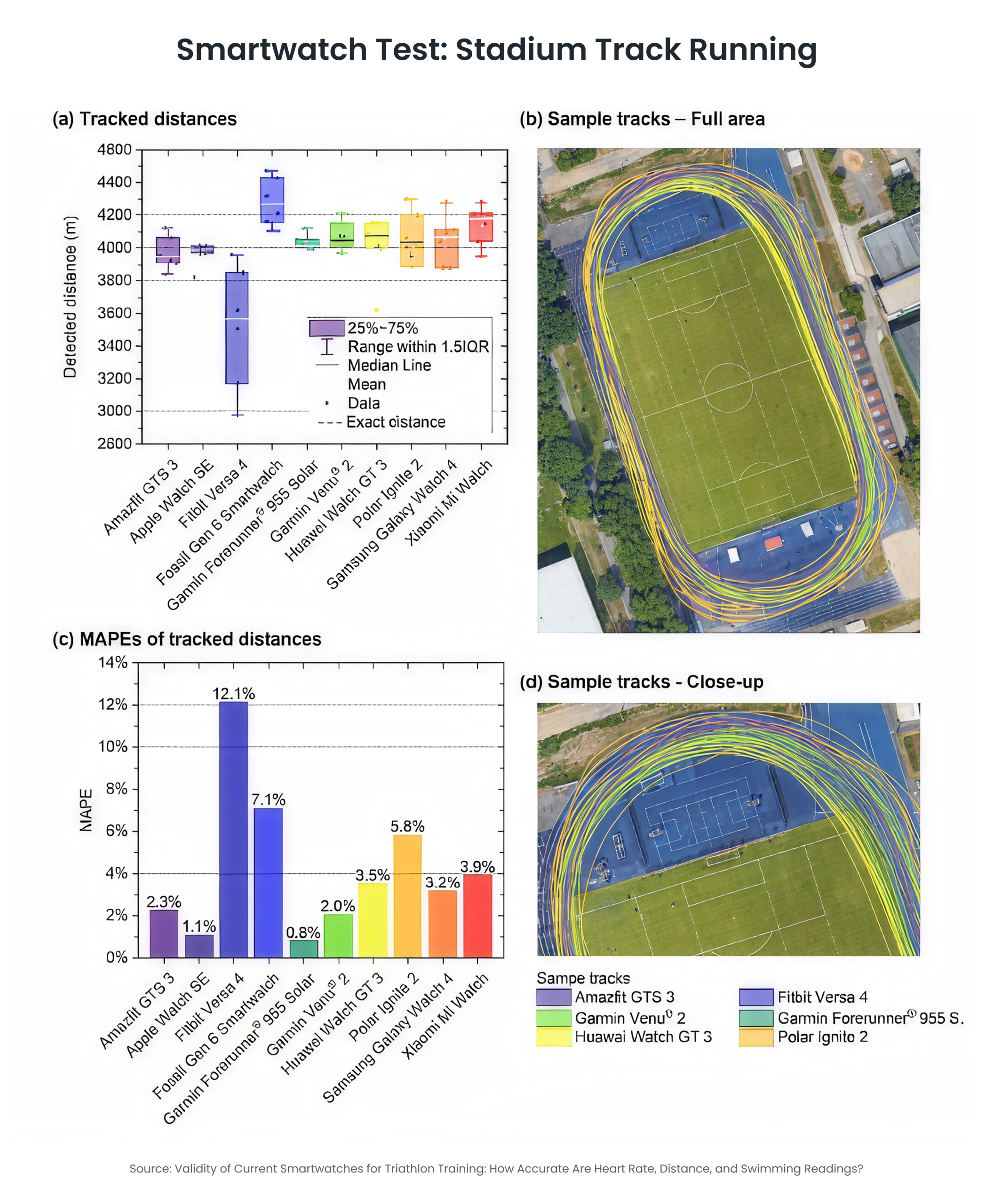
Swimming data
Most smartwatches measured the 400 m front crawl distance fairly accurately and correctly counted stroke transitions at the end of each lap.
However, they struggled with frequent stroke transitions, making them unreliable for more complex swim workouts.
Only a few models, specifically HUA and SAM, tracked stroke rate accurately. Overall, current smartwatches can handle simple lap swimming but aren’t suited for more demanding swim drills with frequent changes in stroke type.
Overall, some smartwatches were fairly accurate, especially for long, straight cycling, but many showed substantial deviations in other exercises.
Key Features of Triathlon Watches
These are the key features to look for when choosing the best triathlon watch:
Heart rate monitoring
This feature allows athletes to measure their heartbeats per minute (BPM) in real-time using optical sensors on the watch’s underside.
Purpose and benefits:
- Enables athletes to train in specific heart rate zones (e.g., aerobic, anaerobic threshold) to maximize the effectiveness of their workouts. You can also use this heart rate zone calculator to compare the results.
- Helps manage pace efforts during a long race to avoid burning out too early.
- Monitors heart rate variability (HRV) and resting heart rate to assess recovery status and prevent overtraining.
Most modern triathlon watches use wrist-based optical heart rate (OHR) sensors that use LEDs to detect blood flow changes. For maximum accuracy, especially during high-intensity intervals or cycling, they can connect to chest-strap heart rate monitors (like a Garmin HRM-Pro) via ANT+ or Bluetooth.
GPS tracking
This feature uses satellite signals to determine your precise location, speed, and direction of movement.
Purpose and benefits:
- Distance and pace. Provides accurate measurements of how far you’ve swum, biked, or run and your current/average pace. This is fundamental for following a race or training plan.
- Route mapping. Records your entire route, allowing you to review your course, analyze elevation gain, and share your activities with others.
- Navigation. Offers features like back-to-start, point-to-point navigation, and full-color mapping to help you stay on course, especially important in open water swims or on unfamiliar bike courses.
Here is how it works
The watch connects to a constellation of global navigation satellite systems (GNSS), which includes not only the US GPS but also the EU’s Galileo. Locking onto multiple satellite systems improves accuracy and reliability.
Traditional GPS can be inaccurate in areas with tall buildings (urban canyons), dense tree cover, or deep valleys. Signals bounce off surfaces and cause a phenomenon called “multipath error”. This may result in a jagged, inaccurate track.
A watch with multi-band GPS can receive signals on multiple frequency bands (e.g., L1 and L5). The L5 frequency is less susceptible to interference and reflection, allowing the watch to identify and correct for multipath errors almost in real-time. his technology provides a remarkably smooth and accurate track of your route, with highly precise distance and pace data, even in challenging environments. It is a significant upgrade over standard single-frequency GPS.
GPS data feeds into numerous other analytics, including:
- Open water swim tracking. GPS is essential for measuring distance in open water, for example, during river swimming. It also measures stroke rate and stroke consistency in areas where pool-style lap counting is impossible.
- Cycling dynamics. When combined with a power meter and other sensors, GPS provides the route context for analyzing power output, climbing performance, and descent speed.
- Running metrics. GPS data is used to calculate ground contact time balance, stride length, and vertical oscillation in conjunction with the watch’s internal accelerometer.
- Race predictions and pacing. Watches use your historical GPS and heart rate data as a running time predictor. It can forecast finish times for various distances and provide real-time pacing guidance to help you achieve your goal.

Data analysis
While heart rate monitoring and GPS tracking collect raw data, data analysis is the feature that transforms this information into actionable insights. It is the intelligence layer that helps athletes understand their performance, plan their training, and optimize their recovery strategies.
Purpose and benefits:
- From data to insight. Moves beyond simply showing “you ran 5 km at a 4:30 min/km pace” to explaining what that effort meant for your body and your fitness.
- Informed decision-making. Provides guidance on how hard to train on a given day, when to rest, and if your training is effectively moving you toward your goals.
- Long-term tracking. Allows you to see trends in your fitness, sleep quality, and overall health tracking over weeks, months, and years.
Key data analysis metrics and features
Modern triathlon watches offer a vast suite of analytical tools. Key ones include:
- Training load. Measures the cumulative strain of your recent activities. It answers the question: “Am I doing too much or too little?”
- Training status. Summarizes your current fitness level by comparing your recent Training Load to your long-term fitness (VO2 Max). It will label your status as, for example, “Peaking,” “Maintaining,” “Productive,” or “Recovery.”
- VO2 max estimate. A proven indicator of cardiovascular fitness. The watch provides an estimate of your maximum oxygen consumption based on your pace/pace and heart rate. You can also use our helpful VO2 max estimator.
- Recovery time. After a workout, the watch provides an estimate of how many hours your body needs to recover before another hard effort.
- Training effect. Measures the impact of a workout on your aerobic and anaerobic fitness systems on a scale from 1.0 to 5.0.
- Race predictions. Based on your VO2 Max and training history, the watch can predict your potential finish times for various running distances (e.g., 5k, marathon).
- Sleep tracking & analysis. Provides a breakdown of sleep stages (light, deep, REM) and assigns a sleep score, offering insights into recovery quality.
- Body battery™ (Garmin watches) / SPARK (Polar flow app). A proprietary feature that uses heart rate variability (HRV), stress, and sleep data to estimate your body’s energy reserves throughout the day.
- Swim metrics (SWOLF). A combined score of stroke count and time that measures swimming efficiency. A lower SWOLF score indicates greater efficiency.
Popular Triathlon Watch Models
The right watch is crucial for triathlon training and racing. The ideal model accurately tracks all three disciplines, offers actionable data for improvement, and can last the entire race. Check out a brief comparison of the most popular options on the market. These watches have been known for catering to different budgets and levels of competition.
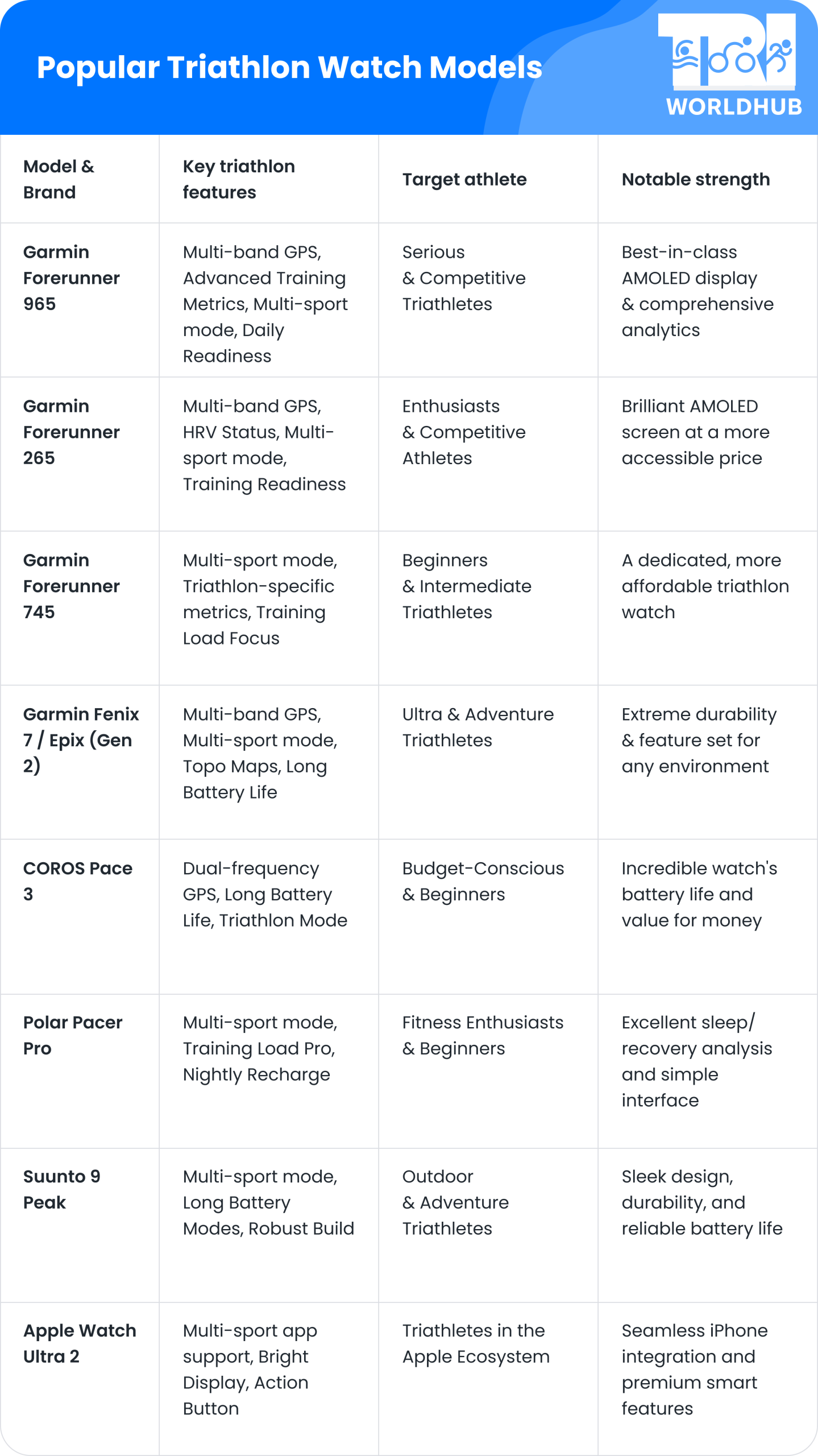
Your triathlon watch selection checklist
Use this list to prioritize features based on your budget, goals, and the type of racing you do.
1. Core triathlon functionality
Check for the following non-negotiables:
- Multisport mode. A dedicated mode that allows you to record swim → bike → run in a single activity with automatic transitions.
- Open water swimming. Must have accurate GPS for distance tracking, pace, and route mapping in open water.
- Pool swimming. Should track laps, stroke type, SWOLF (efficiency score), and distance using an accelerometer.
- Cycling support. Compatibility with external sensors (via ANT+ and Bluetooth) for cycling power meters, cadence sensors, and speed sensors.
- Running metrics. Provides core data like pace, distance, and heart rate, plus advanced metrics like cadence, stride length, and ground contact time balance.
2. Accuracy & sensors
- GPS type. For the best accuracy in challenging conditions (e.g., tree cover, city streets), prioritize Multi-Band or Dual-Frequency GPS.
- Heart rate monitor. A reliable optical heart rate (OHR) sensor is key. Check reviews for accuracy during high-intensity intervals and swimming.
- Sensor connectivity. Ensure it has ANT+ and Bluetooth to connect to chest-based HRMs, bike power meters, cadence sensors, and cycling computers.
3. Battery life
This is critical for long-course athletes.
- General use. Does it last several days with regular tracking and notifications?
- GPS mode. How long does it last with GPS active? (e.g., 20+ hours is safe for a full Ironman).
- Max battery mode. Does it have an ultra-power-saving GPS mode (e.g., Garmin’s UltraTrac, COROS’s Max Battery) that can extend life to 50+ hours for ultramarathons or multi-day events?
4. Data analysis & coaching
- Recovery metrics. Look for features like Training Load, Recovery Time, HRV Status, and Sleep Tracking.
- Training planning. Does it offer daily workout suggestions, built-in training plans, or compatibility with imported plans from platforms like TrainingPeaks?
- Performance analysis. Provides insights like VO2 Max estimate, race predictions, and Training Effect (aerobic/anaerobic).
5. Design & durability
- Build quality. Is it robust enough to handle the rigors of training? (e.g., fiber-reinforced polymer, stainless steel, or titanium bezels).
- Water resistance.Must be rated to 5 ATM (50 meters) or more for swimming.
- Screen type. MIP (Memory-in-Pixel) displays are sunlight-readable and very efficient on battery. AMOLED displays are sharp and colorful but can use more battery.
- Size & weight. Is it comfortable to wear 24/7 for sleep tracking and during all activities?
6. Ecosystem & smart features
- Companion app. Is the associated app (Garmin Connect, Suunto App, COROS App) intuitive and provide the depth of data analysis you want?
- Smart notifications. Do you want calls, texts, and app alerts on your wrist?
- Music. Is built-in storage for music (for offline streaming to Bluetooth headphones) important to you?
- Compatibility. Is it fully compatible with your smartphone’s OS (iOS or Android)?
7. Budget & value
- Set your budget. Prices range from as low as $150 to a hefty price tag of $1,000+. Determine your ceiling.
- Prioritize. Use the checklist above to decide which features are “must-haves” vs. “nice-to-haves” within your budget.
- Consider previous models. Often, last year’s flagship model (e.g., Fenix 6 instead of Fenix 7) can be found at a significant discount and still offers 95% of the features.
Conclusion
Triathlon watches give athletes detailed insights to optimize their training. They track key metrics, such as heart rate, distance, and stroke rate. The right watch can really help you identify your strengths and weaknesses, and even create a comprehensive training plan. You can also use our triathlon training program generator for a well-rounded schedule.
Among the most valued features, athletes mention that measuring training load and tracking recovery really help them prevent overtraining and support better performance. Some watches even offer daily suggested workouts to keep athletes on track with their goals.
Keep in mind that the accuracy of a triathlon watch varies by model and activity. Based on the research that investigated multiple triathlon watches, cycling tends to be more reliable than running or swimming. Also, wrist-based heart rate measurements can differ between individuals. Swimming with frequent stroke changes is challenging for most watches. These are a few things to remember when selecting the right model for your training purposes.
Overall, triathlon watches are powerful tools, but they are not as precise as many people believe they are. So, be aware of their limitations. When used wisely, they can make training more efficient and effective.


